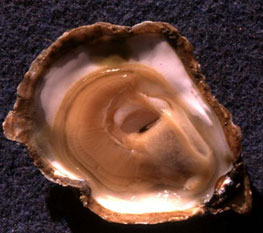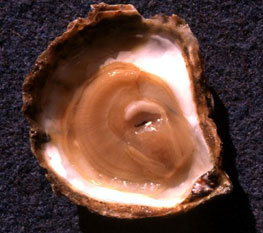Diseases of molluscs
Parasitic diseases—Infection with Marteilia refringens
CLICK ON IMAGE TO ENLARGE

Source: French Research Institute for Exploitation of the Sea-IFREMER
CLICK ON IMAGE TO ENLARGE

Source: French Research Institute for Exploitation of the Sea-IFREMER
Signs of disease
Important: animals with disease may show one or more of the signs below, but disease may still be present in the absence of any signs.
Clinical signs of disease in an infected animal
- poor condition and emaciation
- high mortality
- cessation of growth
Gross signs of disease in an infected animal
- discolouration of digestive gland
- tissue necrosis
Disease agent
Marteilia refringens is a haplosporidium protozoan parasite affecting the digestive system of the flat oyster. In Europe, this disease is commonly known as Aber disease, digestive gland disease of the European oyster, or marteiliosis.
Host range
Molluscs known to be susceptible to the disease:
American oyster* (Crassostrea virginica)
common cockle* (Cardium edule)
European flat oyster* (Ostrea edulis)
New Zealand dredge oyster* (Ostrea chilensis)
Olympia oyster* (Ostrea conchaphila)
rock oyster* (Saccostrea cuccullatta)
Argentinian flat oyster (Ostrea puelchana)
calico scallop (Argopecten gibbus)
mussels (Mytilus edulis, Mytilus galloprovincialis)
Pacific oyster (Crassostrea gigas)
southern mud oyster (Ostrea angasi)
A closely related protozoan, Marteilia sp, has been associated with disease in Saccostrea cuccullata in Western Australia.
* naturally susceptible (other species have been shown to be experimentally susceptible)
Presence in Asia–Pacific
EXOTIC — has not been officially reported in the Asia–Pacific region under the NACA–FAO–OIE quarterly aquatic animal disease reporting program.
Epidemiology
- Infection with Marteilia refringens produces high mortality, associated with sporulation in the epithelial cells of the digestive tubules.
- Earlier stages of sporulation occur in epithelia of the digestive ducts and, possibly, gills.
- An intermediate host or a free-living stage is thought to be required in the lifecycle of this parasite.
- Marteilia refringens can occur in some oysters without causing disease.
- The factors triggering a pathogenic host response are not clearly established, but may include environmental stresses or stock differences in disease resistance.
Differential diagnosis
The differential diagnostic table and the list of similar diseases appearing at the bottom of each disease page refer only to the diseases covered by this field guide. Gross signs observed might well be representative of a wider range of diseases not included here. Therefore, these diagnostic aids should not be read as a guide to a definitive diagnosis, but rather as a tool to help identify the listed diseases that most closely account for the gross signs.
The clinical signs of infection with M. refringens are practically identical to those of infection with other haplosporidia (ie high mortalities associated with colourless and translucent tissues, poor condition, pale digestive gland and a shrunken body). Therefore, any presumptive diagnosis requires histological laboratory examination.
Sample collection
Because of uncertainty in differentiating diseases using only gross signs, and because some aquatic animal disease agents might pose a risk to humans, you should not try to collect samples unless you have been trained. Instead, you should phone your national hotline number and report your observations. If samples have to be collected, the agency taking the call will advise you on what you need to do. Local or district fisheries/veterinary authorities could advise you on sampling.
Emergency disease hotline
For your national emergency disease hotline number, see Whom to contact if you suspect a disease.
Further reading
http://www.oie.int/aac/eng/cards/en_diseasecard.htm
http://www.pac.dfo-mpo.gc.ca/sci/shelldis/pages/madoy_e.htm
The currently accepted procedures for a conclusive diagnosis of infection with Marteilia refringens are summarised at http://www.oie.int/eng/normes/fmanual/A_00040.htm
These hyperlinks were correct and functioning at the time of publication.

